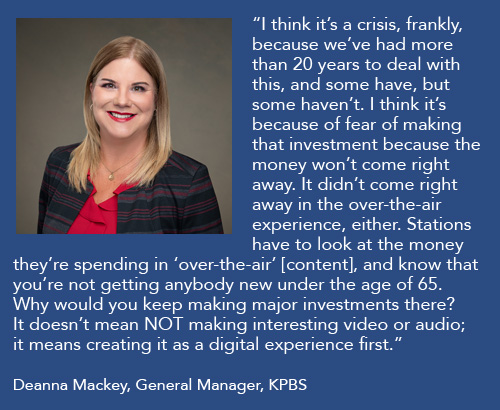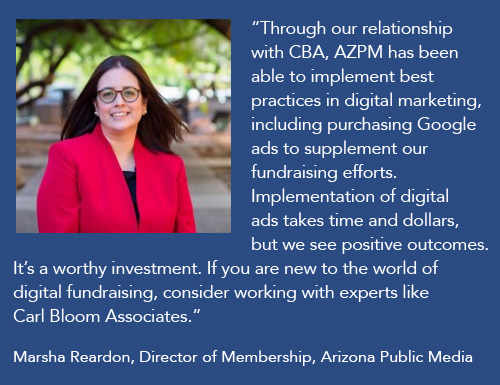It’s no longer ‘digital first’; it’s ‘digital or die’
SPONSORED
Why Digital First is the future you can’t ignore
By Carl Bloom Associates, Inc.

“Build it, and they will come.”
That may have worked in Field of Dreams, but creating “digital first” content for public media stations isn’t enough. It’s certainly a good start. However, discovery and consumption are left to chance if audiences aren’t led to all the great content.
To find and engage with new audiences, public media stations must look outside traditional platforms and promote all the great digital content in the spaces where audiences spend time: via online advertising on Google and the major social media platforms. Simple, right?
It’s not simple at all. As it turns out, digital ad marketing is complicated and requires expertise that often doesn’t exist within the organization. But where there are challenges, there are opportunities.
In this article, we’ll explore strategies that public media stations and nonprofits use to engage audiences through digital platforms and how to use free resources and paid advertising to reach new audiences and turn them into donors.
Keywords: DIGITAL FIRST
Deanna Mackey, General Manager of KPBS, touched upon the “digital first” concept during a panel on the future of fundraising at the 2022 PMDMC, noting that “digital first” is not meant to be a pivot from traditional platforms but something that must be added. Whether content, marketing, or fundraising, the key to success is cultivating audiences and donors where they are.
We’ve all heard the term “digital first,” but as with all buzzwords, it’s essential to understand the meaning and how it relates to your organization.
“Digital first” refers to the need to function, strategize, and create experiences with the mindset that the digital landscape for consumers and donors is changing faster than ever and that organizations must innovate to keep up.
The COVID pandemic pushed digital initiatives into overdrive by forcing rapid change and adaptation, resulting in consumers expecting to be able to do more and find what they are looking for online with less friction. As a result, companies and organizations must continue to adapt to satisfy the needs of consumers and donors.
With that said, public media stations continue to use traditional forms of media and marketing to reach a loyal demographic. “Digital first” is not meant to replace what works but to add to the tried and true, successful practices while building towards the future as behavior and engagement continue to shift with the aging population.
To be clear, when we say marketing, we mean various ways stations engage with audiences and donors. In organizations that have separate marketing and fundraising departments, tasks are often split into programming/content and membership/development.
And, of course, engagement is defined differently by various departments within an organization.
Keyword: INVESTMENT

At the end of a session on TV audience trends at the 2022 PMDMC, KPBS General Manager Deanna Mackey strongly advised that stations make significant investments in digital content, focusing more on social media and digital platforms rather than over-the-air.
She stressed that national content was traditionally the big driver in fundraising for many years, but now and in the future, that isn’t and won’t be enough to keep audiences engaged.
Stations must build and promote good local content with local talent and provide experiences and events through social media, podcasts, etc. In December 2021, CPB announced an investment in 75 public media stations to encourage digital innovation in content areas.
That is an approach adopted by the BBC this past summer.
Keyword: ENGAGEMENT
Suppose locally-generated content is strategically focused on meeting audiences where they are. In that case, marketing and membership need to be in that space to engage audiences so that the station can educate and inspire them to fund the growth of new and existing content.
KPBS, for example, is joining other public media stations and dozens of nonprofits to invest in digital advertising through CBA Digital Reach 360 program.

CBA Digital Reach 360 is a continuous, strategic digital ad program that uses an organization’s Google Ad Grant, Google’s paid online ads, and social media ads to supercharge engagement and fundraising.
Managed by CBA’s digital guru Tracy Sodd, CBA Digital Reach 360 cultivates current and prospective donors, building relationships based on the audience’s desire for quality content. The program is designed to expand the station’s reach, acquire new donors, generate additional gifts and interact with audiences whose interests align with your mission.
Keyword: AWARENESS
ideastream (Cleveland) has three core over-the-air services: NPR news, Classical, and PBS. Each platform has a set of goals based on the station’s strategic plan, which focuses on helping audiences build listening and viewing habits.

Matt Erman, Director of Marketing at ideastream, has used CBA Digital Reach 360 for the station’s rebranding needs for more than a year. Through the use of CBA Digital Reach 360, ideastream’s rebranding has been promoted 13 million times at the cost of just $11,000 to encourage core services, making audiences aware of the signal changes of their classical and news services and focus on education.
ideastream’s WCLV Classical station’s terrestrial signal change can expand services to 1 million people. This opportunity has prompted Erman to turn to CBA Digital Reach 360 to build awareness for WCLV and ideastream’s NPR station, WKSU. Goals include serving news ‘deserts’ through partnership with the Ohio Newsroom, increasing listener loyalty on both stations, and converting habitual listeners to members.
Under the CBA Digital Reach 360 umbrella, Carl Bloom Associates manages ideastream’s Google Grant, bringing over 50,000 people to ideastream’s website.
Keyword: VARIETY
The design of the program itself is not ours—it’s yours.
CBA Digital Reach 360 allows public media stations to customize a program that fits their engagement goals—PBS Passport tune-in and activations, Youtube content, vehicle donations, sustainer conversion, targeting high-dollar donors, or all of the above.
CBA Digital Reach 360 is flexible—it’s also used to promote job listings, program awareness, voter information services, events, and podcasts. As priorities change, Carl Bloom Associates pivots with stations to ensure that advertising dollars are allocated to new efforts for maximum effect.
We utilize Google search, display ads, Meta platforms, app store ads, and the station’s website to engage audiences to turn engagement into net revenue that can be invested in your mission.
CBA Digital Reach 360 is not limited to public media stations. The program is also in place at Habitat for Humanity affiliates, public libraries, and more. Habitat For Humanity Metro Maryland utilized CBA Digital Reach 360 to promote their big summer fundraising event, a polo match, with cheeky ads designed to catch attention.

Keyword: RESULTS
Your organization could receive $120,000 in free Google ads, as have ideastream and thousands of other nonprofits. Google Ad Grants launched in 2003, and if your station isn’t taking advantage of them, a lucrative opportunity may pass you by.
Carl Bloom Associates recommends not only using the allotment of free ads but also making a modest investment in other Google ads to bolster your campaigns.
By tapping into their Google Ad Grant and using free ads:
- West Virginia Public Broadcasting (WVPB) drove over 75,000 unique visitors to its website.
- More than 18,000 people have visited a branch of Brooklyn Public Library due to interacting with a free ad. Plus, 61,000 people have visited their website, all driven by free ads.

When paid ads were added to the online marketing mix:
- Arizona Public Media (AZPM) generated $8,000 in fundraising income after spending just $1,500 on paid Google ads.
- A California station spent less than $1,000 in paid Calendar Year-End ads and generated more than $96,000 in revenue.
Free ads via the Google Ad Grant program drive enormous engagement, and small investments in paid ads can result in an impressive ROI.
Keyword: EXPERTISE
CBA has cracked the code for delivering digital ads that work, and our expertise is deep.
The CBA Digital Reach 360 program includes turn-key, year-round management of Google Ad Grants and the creation of the free ads that the grant provides, as well as paid online advertising designed to supercharge engagement and fundraising.
CBA Digital Reach 360 will cultivate current and prospective donors, building relationships based on the audience’s desire to support a cause, be more involved in their community, and make a difference. Those efforts are designed to generate additional gifts and allow organizations to engage with audiences further.
Click here to learn more about CBA Digital Reach 360.
Contact Christina McPhillips for more information and to schedule a CBA Digital Reach 360 demo: christina@carlbloom.com.
Founded in 1976, Carl Bloom Associates has expertise in integrated marketing through traditional direct mail and cutting-edge digital channels and continues to innovate for clients in various sectors, including public media.


